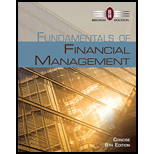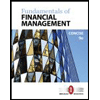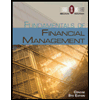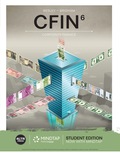
Integrated Case
NEW WORLD CHEMICALS INC.
16-16 FINANCIAL
Assume that you were recently hired as Wilson’s assistant and that your first major task is to help her develop the formal financial forecast. She asks you to begin by answering the following questions.
- a. Assume (1) that NWC was operating at full capacity in 2014 with respect to all assets. (2) that all assets must grow at the same rate as sales. (3) that accounts payable and accrued liabilities also will grow at the same rate as sales, and (4) that the 2014 profit margin and dividend payout will be maintained. Under those conditions, what would the AFN equation predict the company's financial requirements to be for the coming year?
- b. Consultations with several key managers within NWC, including production, inventory, and receivable managers, have yielded some very useful information.
- 1. NWC’s high DSO is largely due to one significant customer who battled through some hardships the past 2 years but who appears to be financially healthy again and is generating strong cash flow. As a result, NWC’s
accounts receivable manager expects the firm to lower receivables enough for a calculated DSO of 34 days without adversely affecting sales. - 2. NWC was operating slightly below capacity; but its forecasted growth will require a new facility, which is expected to increase NWC's net fixed assets to $700 million.
- 3. A relatively new inventory management system (installed last year) has taken some time to catch on and to operate efficiently. NWC's inventory turnover improved slightly last year, but this year NWC expects even more improvement as inventories decrease and inventory turnover is expected to rise to 10 ×.
- 1. NWC’s high DSO is largely due to one significant customer who battled through some hardships the past 2 years but who appears to be financially healthy again and is generating strong cash flow. As a result, NWC’s
Incorporate that information into the 2015 initial forecast results, as these adjustments to the initial forecast represent the final forecast for 2015. (Hint: Total assets do not change from the initial forecast.)
- c. Calculate NWC’s forecasted ratios based on its final forecast and compare them with the company’s 2014 historical ratios, the 2015 initial forecast ratios, and the industry averages. How does NWC compare with the average firm in its industry, and is the company’s financial position expected to improve during the coming year? Explain.
- d. Based on the final forecast, calculate NWC’s
free cash flow for 2015. How does this FCF differ from the POP forecasted by NWC's initial “business as usual” forecast? - e. Initially, some NWL managers questioned whether the new iacility expansion was necessary, especially as it results in increasing net fixed assets from $500 million to $700 million (a 40% increase). However, after extensive discussions about NWC needing to position itself for future growth and being flexible and competitive in today’s marketplace, NWC’s top managers agreed that the expansion was necessary. Among the issues raised by opponents was that NWC’s fixed assets were being operated at only 85% of capacity. Assuming that its fixed assets were operating at only 85% of capacity, by how much could sales have increased, both in dollar terms and in percentage terms, before NWC reached full capacity?
- f. How would changes in the following items affect the AFN: (1) the dividend payout ratio, (2) the profit margin, (3) the capital intensity ratio, and (4) NWC beginning to buy from its suppliers on terms that permit it to pay after 60 days rather than after 30 days? (Consider each item separately and hold all other things constant)
Financial Statements and Other Data on NWC (Millions of Dollars) Table 1C 16.1
| A. |
2014 | 2015E |
| Cash and equivalents | $ 20 | $ 25 |
| Accounts receivable | 240 | 300 |
| Inventories | 240 | 300 |
| Total current assets | S 500 | $ 625 |
| Net fixed assets | 500 | 625 |
| Total assets | $1,000 | $1,250 |
| Accounts payable and accrued liabilities | $ 100 | $ 125 |
| Notes payable | 100 | 190 |
| Total current liabilities | $ 200 | $ 315 |
| Long-term debt | 100 | 190 |
| Common stock | 500 | 500 |
| 200 | 245 | |
| Total liabilities and equity | $1,000 | $1,250 |
| B. Income Statements | 2014 | 2015E |
| Sales | $2,000.00 | $2,500.00 |
| Variable costs | 1,200.00 | 1,500.00 |
| Fixed costs | 700.00 | 875.00 |
| Earnings before interest and taxes (EBIT) | $ 100.00 | $ 125.00 |
| Interest | 16.00 | 16.00 |
| Earnings before taxes (EBT) | $ 84.00 | $ 109.00 |
| Taxes (40%) | 33.60 | 43.60 |
| Net income | $ 50.40 | $ 65.40 |
| Dividends (30%) | $ 15.12 | $ 19.62 |
| Addition to retained earnings | $ 35.28 | $ 45.78 |
| C. Key Ratios | NWC (2014) | NWC (2015E) | Industry | Comment |
| Basic earning power | 10.00% | 10.00% | 20.00% | |
| Profit margin | 232 | 2.62 | 4.00 | |
| 7.20 | 8.77 | 15.60 | ||
| Days sales outstanding (365 days) | 43.80 days | 43.80 days | 32.00 days | |
| Inventory turnover | 8.33× | 8.33× | 11.00× | |
| Fixed assets turnover | 4.00 | 4.00 | 5.00 | |
| Total assets turnover | 2.00 | 2.00 | 2.50 | |
| Total 1iabi1ities/Assets | 30.00% | 40.40% | 36.00% | |
| Times interest earned | 6.25 × | 7.81× | 9.40× | |
| Current ratio | 2.50 | 1.99 | 3.00 | |
| Payout ratio | 30.00% | 30.00% | 30.00% |
Want to see the full answer?
Check out a sample textbook solution
Chapter 16 Solutions
Bundle: Fundamentals of Financial Management, Concise Edition (with Thomson ONE - Business School Edition, 1 term (6 months) Printed Access Card), 8th + Aplia Printed Access Card
- Unite Assissment 02 : New City Band Part 02: Base & Flexible Budget Base Budget Flexible Budget Fixed or Variable Revenue City Contributions Fixed Annual Contribution F Per Concert Contributions V Public Contributions V Endowment Earnings F Total Revenue Expenses Conductors Stipend F Musicians Stipend V Insurance Fixed Insurance Premium F Per-Concert Insurance Premium V Music Costs Music Acquisitions F Performance Rights V Total Expenses Surplus/(Deficit)arrow_forwardSonja Jensen is considering the purchase of a fast-food franchise. Sonja will be operating on a lot that is to be converted into a parking lot in six years, but that may be rented in the interim for $700 per month. The franchise and necessary equipment will have a total initial cost of $68,000 and a salvage value of $9,000 (in today's dollars) after six years. Sonja is told that the future annual general inflation rate will be 5%. The projected operating revenues and expenses (in actual dollars) other than rent and depreciation for the business are given in the table below. Assume that the initial investment will be depreciated under the five-year MACRS and that Sonja's tax rate will be 30%. Sonja can invest her money at a rate of at least 14% in other investment activities during this inflation-ridden period. Click the icon to view the projected operating revenues and expenses. Click the icon to view the MACRS depreciation schedules. (a) Determine the cash flows associated with the…arrow_forwardSonja Jensen is considering the purchase of a fast-food franchise. Sonja will be operating on a lot that is to be converted into a parking lot in six years, but that may be rented in the interim for $700 per month. The franchise and necessary equipment will have a total initial cost of $68,000 and a salvage value of $9,000 (in today's dollars) after six years. Sonja is told that the future annual general inflation rate will be 5%. The projected operating revenues and expenses (in actual dollars) other than rent and depreciation for the business are given in the table below. Assume that the initial investment will be depreciated under the five-year MACRS and that Sonja's tax rate will be 30%. Sonja can invest her money at a rate of at least 14% in other investment activities during this inflation-ridden period. Click the icon to view the projected operating revenues and expenses. Click the icon to view the MACRS depreciation schedules. (a) Determine the cash flows associated with the…arrow_forward
- Unit 02 Part 3: New City BandAs the volunteer business manager for the New City Band (City Band), you are responsible for preparing the operating budget for the organization’s upcoming summer concert season. Each year, City Band presents up to 20 weekend performances, depending on weather conditions. The concerts are free to the public,but the band hangs a pot from the bandstand and people leave small donations in it. On average, City Band gets $100 in donations at each of its performances. In addition to donations, New City pays the band $3,000 per season plus $125 for each performance.City Band also has a small endowment of $100,000 on which it expects to earn 3.5 percent in the coming fiscal year. City Band’s trustees have decided to use that money to pay for operating expenses if they need to.City Band pays its conductor $3,000 for the summer season and has aninsurance policy to protect it against any loss of equipment or damage to the bandstand. That policy costs the band…arrow_forwardhow to solvearrow_forwardHow much working capital does Airbnb have for the year 2024? Discuss the components of working capital and calculations. What is the amount of the total assets that Airbnb reported for the year 2024? List the assets included. What is the amount of the total liabilities that tAirbnb reported for the year 2024? List the liabilities included.arrow_forward
- How much working capital does Airbnb have for the year 2024? State the components of working capital and calculations. What is the amount of the total assets that Airbnb reported for the year of 2024 and list the assets?arrow_forwardWhat is an account that requires present value calculations. State both the account name and the amount for the account you select. What inventory method does Airbnb employ and explain how this method works? Calculate Airbnb inventory turnover for the year 2024. What does inventory turnover tells an investor?arrow_forwardWhat was the free cash flow for the year 2024 for Airbnb and formula used for their calculations? Explain the importance of free cash flow.arrow_forward
- What is the useful lives for the various types of property, plant, and equipment owned by Airbnb?arrow_forwardWhat depreciation method does Airbnb employ and how does this depreciation method works? Does Airbnb have any impaired assets?arrow_forwardNew City BandAs the volunteer business manager for the New City Band (City Band), you are responsible for preparing the operating budget for the organization’s upcoming summer concert season. Each year, City Band presents up to 20 weekend performances, depending on weather conditions. The concerts are free to the public,but the band hangs a pot from the bandstand and people leave small donations in it. On average, City Band gets $100 in donations at each of its performances. In addition to donations, New City pays the band $3,000 per season plus $125 for each performance.City Band also has a small endowment of $100,000 on which it expects to earn 3.5 percent in the coming fiscal year. City Band’s trustees have decided to use that money to pay for operating expenses if they need to.City Band pays its conductor $3,000 for the summer season and has aninsurance policy to protect it against any loss of equipment or damage to the bandstand. That policy costs the band $500 for the summer plus…arrow_forward
 Fundamentals of Financial Management, Concise Edi...FinanceISBN:9781305635937Author:Eugene F. Brigham, Joel F. HoustonPublisher:Cengage Learning
Fundamentals of Financial Management, Concise Edi...FinanceISBN:9781305635937Author:Eugene F. Brigham, Joel F. HoustonPublisher:Cengage Learning Fundamentals of Financial Management, Concise Edi...FinanceISBN:9781285065137Author:Eugene F. Brigham, Joel F. HoustonPublisher:Cengage Learning
Fundamentals of Financial Management, Concise Edi...FinanceISBN:9781285065137Author:Eugene F. Brigham, Joel F. HoustonPublisher:Cengage Learning



